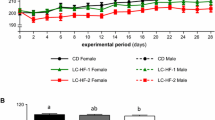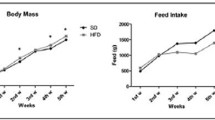Abstract
Background
High-fat diets are usually associated with greater weight (W) gain and body fat (BF). However, it is still unclear whether the type and amount of fat consumed influence BF. Additionally, dietary fat intake may also have consequences on skeletal health.
Objective
To evaluate in healthy growing rats the effects of high-fat diets and type of dietary fat intake (saturated or vegetable oils) on energy and bone metabolism.
Methods
At weaning, male Wistar rats (n = 50) were fed either a control diet (C; fat = 7% w/w) or a high-fat diet (20% w/w) containing either: soybean oil, corn oil (CO), linseed oil (LO), or beef tallow (BT) for 8 weeks. Zoometric parameters, BF, food intake and digestibility, and total and bone alkaline phosphatase (b-AP) were assessed. Total skeleton bone mineral density (BMD) and content (BMC), BMC/W, spine BMD, and bone volume (static-histomorphometry) were measured.
Results
Animals fed BT diet achieved lower W versus C. Rats fed high-fat vegetable oil diets showed similar effects on the zoometric parameters but differed in BF. BT showed the lowest lipid digestibility and BMC. In contrast, high vegetable oil diets produced no significant differences in BMC, BMC/W, BMD, spine BMD, and bone volume. Marked differences were observed for LO and BT groups in b-AP and CO and BT groups in bone volume.
Conclusion
BT diet rich in saturated fatty acids had decreased digestibility and adversely affected energy and bone metabolisms, in growing healthy male rats. There were no changes in zoometric and bone parameters among rats fed high vegetable oil diets.


Similar content being viewed by others
Abbreviations
- AA:
-
Arachidonic acid
- ALA:
-
Linolenic acid
- BMC:
-
Body mineral content
- BMD:
-
Body mineral density
- BT:
-
Beef tallow
- CO:
-
Corn oil
- DHA:
-
Docosahexaenoic acid
- DXA:
-
Dual-energy X-ray absorptiometry
- EPA:
-
Eicosapentaenoic acid
- LA:
-
Linoleic acid
- LO:
-
Linseed oil
- PGE:
-
Prostaglandin E
- PUFA:
-
Polyunsaturated fatty acids
- SO:
-
Soybean oil
References
Peña M, Bacallao J (eds) (2000) La obesidad en la pobreza: un problema emergente en las Américas. In: La obesidad en la pobreza: un reto para la Salud Pública. Organización Panamericana de la Salud, Publicación Científica No 576, Washington, pp 3–11
Bessesen DH (2008) Update on obesity. J Clin Endocrinol Metab 93(6):2027–2034
Wang Y, Beydoun MA, Liang L, Caballero B, Kumanyika SK (2008) Will all Americans become overweight or obese? estimating the progression and cost of the US obesity epidemic. Obesity 16(10):2323–2330
Britos S (2008) Transición nutricional, obesidad y desafíos para las políticas públicas y los agronegocios http://www.nutrinfo.com
Bautista LE, Casas JP, Herrera VM, Miranda JJ, Perel J, Pichardo R et al (2009) The Latin American consortium of studies in obesity (LASO). Obes Rev 10(3):364–370
Warwick ZS, McGuire CM, Bowen KJ, Synowski SJ (2000) Behavioral components of high-fat diet hyperphagia: meal size and postprandial satiety. Am J Physiol Regul Integr Comp Physiol 278(1):R196–R200
West DB, York B (1998) Dietary fat, genetic predisposition, and obesity: lessons from animal models. Am J Clin Nutr 67(3 Suppl):505S–512S
Zemel MB, Shi H, Greer B, Dirienzo D, Zemel PC (2000) Regulation of adiposity by dietary calcium. Faseb J 14(9):1132–1138
Gunnes M, Lehmann EH (1995) Dietary calcium, saturated fat, fiber and vitamin C as predictors of forearm cortical and trabecular bone mineral density in healthy children and adolescents. Acta Paediatr 84:388–392
Wohl GR, Loehrke L, Watkins BA, Zernicke RF (1998) Effects of high-fat diet on mature bone mineral content, structure, and mechanical properties. Calcif Tissue Int 63:74–79
Watkins BA, Li Y, Seifert MF (2006) Dietary ratio of n-6/n-3 PUFAs and docosahexaenoic acid: actions on bone mineral and serum biomarkers in ovariectomized rats. J Nutr Biochem 17(4):282–299
Watkins BA, Seifert MF (2000) Conjugated linoleic acid and bone biology. J Am Coll Nutr 19(4):478S–486S
Watkins BA, Li Y, Lippman HE, Seifert MF, Bruce A (2001) Omega-3 polyunsaturated fatty acids and skeletal health. Exp Biol Med 226(6):485–497
Mollard RC, Kovacs HR, Fitzpatrick-Wong SC, Weiler HA (2005) Low levels of dietary arachidonic and docosahexaenoic acids improve bone mass in neonatal piglets, but higher levels provide no benefit. J Nutr 135(3):505–512
Watkins BA, Li Y, Allen KG, Hoffmann WE, Seifert MF (2000) Dietary ratio of (n-6)/(n-3) polyunsaturated fatty acids alters the fatty acid composition of bone compartments and biomarkers of bone formation in rats. J Nutr 130(9):2274–2284
Appleton D, Lockwood GB (2006) Building bones with nutraceuticals. Pharmaceutical J 277:78–83
Reeves P, Nielsen F, Fahey G Jr (1993) AIN-93 purified diets for laboratory rodents: final report of the American Institute of Nutrition ad hoc writing committee on the reformulation of the AIN-76A rodent diet. J Nutr 123:1939–1951
Valk EE, Hornstra G (2000) Relationship between vitamin E requirement and polyunsaturated fatty acid intake in man: a review. Int J Vitam Nutr Res 70(2):31–42
Zeni SN, Gregorio S, Gomez AC, Somoza J, Mautalen C (2002) Olpadronate prevents the bone loss induced by cyclosporine in the rat. Calcif Tissue Int 70(1):48–53
Zeni SN, Wittich C, Di Gregorio S, Casco C, Oviedo A, Somoza J et al (2001) Utilidad clínica de los marcadores de formación y resorción osea. Acta Bioquím Clín Latinoam XXXV(1):3–36
Association of Official Agricultural Chemists (AOAC) (1990) Official methods for analysis, 15th edn. US Government Printing Office, Washington
Friedman SM, Gamba CA, Boyer PM, Guglielmotti MB, Vacas MI, Rodriguez PN, Guerrero C, Lifshitz F (2001) Growth deceleration and bone metabolism in nutritional dwarfing rats. Int J Food Sci Nutr 52(3):225–233
Mailhot G, Rabasa-Lhoret R, Moreau A, Berthiaume Y, Levy E (2010) CFTR depletion results in changes in fatty acid composition and promotes lipogenesis in intestinal caco 2/15 cells. PLoS One 5(5):e10446
Ratnayake WM, Galli C (2009) Fat and fatty acid terminology, methods of analysis and fat digestion and metabolism: a background review paper. Ann Nutr Metab 55(1–3):8–43
Uauy R (2009) Dietary fat quality for optimal health and well-being: overview of recommendations. Ann Nutr Metab 54(suppl 1):2–7
Brinkworth GD, Noakes M, Buckley JD, Keogh JB, Clifton PM (2009) Long-term effects of a very-low-carbohydrate weight loss diet compared with an isocaloric low-fat diet after 12 mo. Am J Clin Nutr 90(1):23–32
Lapillonne A, Clarke SD, Heird WC (2003) Plausible mechanisms for effects of long-chain polyunsaturated fatty acids on growth. J Pediatr 143(4 Suppl):S9–S16
Moussavi N, Gavino V, Receveur O (2008) Could the quality of dietary fat, and not just its quantity, be related to risk of obesity? Obesity 16(1):7–15
Oh SR, Sul OJ, Kim YY, Kim HJ, Yu R, Suh JH, Choi HS (2010) Saturated fatty acids enhance osteoclast survival. J Lipid Res 51(5):892–899
Byers S, Moore AJ, Byard RW, Fazzalari NL (2000) Quantitative histomorphometric analysis of the human growth plate from birth to adolescence. Bone 27(4):495–501
Raisz LG, Alander CB, Simmons HA (1989) Effects of prostaglandin E3 and eicosapentaenoic acid on rat bone in organ culture. Prostaglandins 37:615–662
Raisz LG (1999) Prostaglandins and bone: physiology and pathophysiology. Osteoarthritis Cartilage 7:419–421
Cohen SL, Ward WE (2005) Flaxseed oil and bone development in growing male and female mice. J Toxicol Environm Health, Part A 68:1861–1870
Lavie CJ, Milani RV, Mehra MR, Ventura HO (2009) Omega-3 polyunsaturated fatty acids and cardiovascular diseases. J Am Coll Cardiology 11:585–594
Friedman S, Portela ML, Rodriguez P, Almajano Pablos MP, Riba Sicart M (2008) Estudio comparativo entre los hábitos alimentarios de estudiantes universitarios argentinos y catalanes: aspectos nutricionales. Rev Esp Nutr Com 14(4):210–218
Calder PC, Yaqoob P (2009) Omega-3 polyunsaturated fatty acids and human health outcomes. Biofactors 35(3):266–272
Buettner R, Parhofer KG, Woenckhaus M, Wrede CE, Kunz-Schughart LA, Schölmerich J, Bollheimer LC (2006) Defining high-fat-diet rat models: metabolic and molecular effects of different fat types. J Mol Endocrinol 36(3):485–501
Bishara H, Walker H (1977) The vitamin B, status of pigs given a diet containing linseed meal. Br J Nutr 37:321–331
Friedman SM, Boyer PM, Barrio Rendo ME, Morasso MC, Gamba AC, Rio ME (1999) Evaluación del crecimiento normal en ratas a través del puntaje Z. ALAN 49(2):143–148
Zago V, Lucero D, Macri EV, Cacciagiú L, Gamba CA, Miksztowicz V, Berg G, Wikinski R, Friedman S, Schreier L (2010) Circulating VLDL lipoprotein characteristics resulting from fatty liver in an insulin resistance rat model. Ann Nutr Metab 56:198–206
Acknowledgments
We thank Cecilia Ramos for biochemical determinations and Ricardo Orzuza for technical assistance and care of experimental animals. This study was supported by University of Buenos Aires grant UBACyT O008 y O015, 2008–2011, Argentina, by Pediatric Sunshine Academics Inc., Santa Barbara, CA, USA and by Molinos Río de la Plata, Buenos Aires, Argentina.
Conflict of interest
There was no conflict of interest associated with this study by any of the authors.
Author information
Authors and Affiliations
Corresponding author
Rights and permissions
About this article
Cite this article
Macri, E.V., Gonzales Chaves, M.M., Rodriguez, P.N. et al. High-fat diets affect energy and bone metabolism in growing rats. Eur J Nutr 51, 399–406 (2012). https://doi.org/10.1007/s00394-011-0223-2
Received:
Accepted:
Published:
Issue Date:
DOI: https://doi.org/10.1007/s00394-011-0223-2




